To clean like a pro, start by decluttering your space to make cleaning easier. Use a top-to-bottom approach when dusting, and move in a clockwise direction around the room for thorough coverage. Don't forget your essential tools, such as microfiber cloths and HEPA-filtered vacuums. Allow cleaning products to dwell for best results, and prioritize high-traffic areas like kitchens and bathrooms. Establishing a regular cleaning schedule and using a checklist will help maintain focus. By incorporating these techniques, you'll elevate your cleaning game and enhance efficiency. Keep exploring to discover even more expert strategies and tips!
Effective Cleaning Start Techniques
When you begin cleaning, decluttering the area first can make a significant difference in how manageable the task feels. Start by removing unnecessary items from surfaces and putting things back in their designated spots. This not only simplifies your cleaning process but also helps you see what needs attention.
Next, implement an effective cleaning strategy by dusting surfaces from top to bottom. Tackle high areas like ceiling fans and shelves first, so any debris falls to lower surfaces. This way, you won't have to clean the same areas multiple times.
Another great cleaning tip is to use a clockwise approach in each room. This method guarantees you cover every corner and don't miss any spots.
As you work, keep a checklist handy to track your progress. It helps you stay organized and focused, making your cleaning more efficient. Additionally, incorporating daily decluttering tasks into your routine can enhance the overall effectiveness of your cleaning sessions.
When using cleaning products, remember to let them sit for at least 15 minutes. This allows for maximum effectiveness, making sure surfaces are cleaned thoroughly.
Essential Cleaning Tools
Equipping yourself with the right cleaning tools can make all the difference in achieving a spotless home. Start with microfiber cloths, which can eliminate up to 99% of bacteria using just water. This makes them highly effective for sanitizing surfaces without harsh chemicals. Additionally, using proper storage for your cleaning tools ensures they remain organized and accessible.
A cleaning caddy is also essential; it helps you organize your tools and supplies, keeping all-purpose cleaners, glass cleaner, sponges, and latex gloves within easy reach.
For tackling dust and allergens, high-quality mops and HEPA-filtered vacuums are a must. These vacuums greatly improve dust removal, creating a healthier indoor environment. Regular vacuuming with HEPA filters also captures small particles, enhancing the air quality in your home.
You'll also want specialized scrub brushes and melamine sponges in your arsenal. They work wonders on tough stains and hard-to-reach areas without scratching surfaces. Regular maintenance of your vacuum cleaner can further ensure its effectiveness in tackling dirt and debris.
Lastly, don't overlook the importance of extendable dusters. They allow you to efficiently clean high surfaces, like ceiling fans and light fixtures, without needing a ladder.
Allowing Product Activation
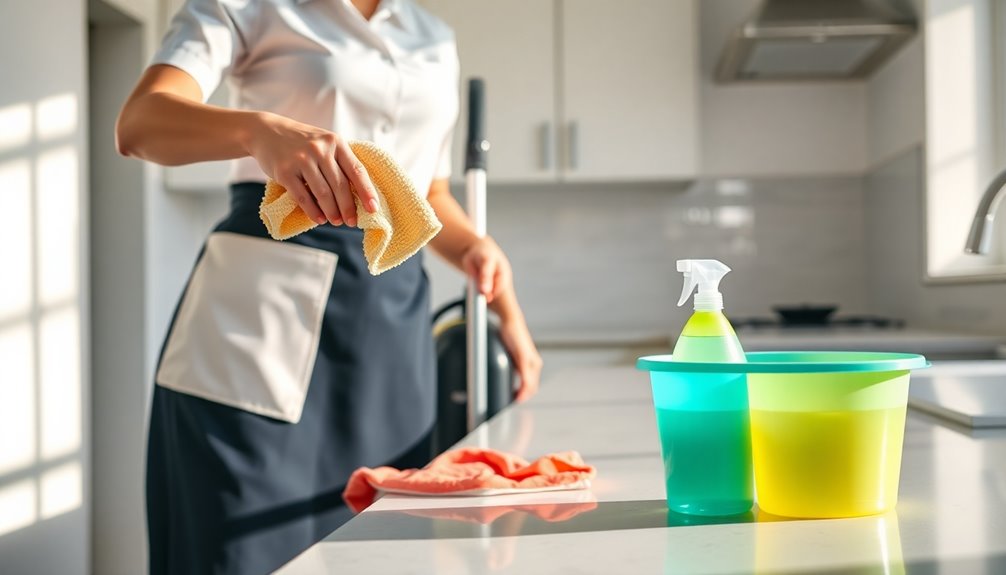
Using the right cleaning tools sets the stage for effective cleaning, but how you apply those products can make a big difference too. One essential technique to enhance the effectiveness of your cleaning products is allowing product activation. By letting cleaning products sit for about 15 minutes before wiping them away, you give them the time they need to break down dirt and grime effectively. This simple step can considerably minimize scrubbing, conserving your energy and reducing wear on surfaces. Additionally, regular disinfection is essential for maintaining a hygienic bathroom environment, which can be achieved through proper product application.
Different types of cleaning products, like degreasers and disinfectants, have specific activation times for best results, so it's important to follow the manufacturer's guidelines. For example, many disinfectants, such as Clorox Clean-Up Cleaner + Bleach, require a certain dwell time to effectively kill pathogens. Applying products directly to soiled areas and allowing them to penetrate the surface not only improves cleaning outcomes but also cuts down on overall cleaning time. You won't have to worry about repeated applications, making your cleaning routine more efficient. Additionally, regular maintenance helps ensure that surfaces remain clean and hygienic, further enhancing the effectiveness of your cleaning efforts.
Incorporating these cleaning techniques into your regimen can elevate your cleaning experience, making it easier and more effective. Remember, allowing product activation is key to achieving the best results with minimal effort.
Specialized Cleaning Tips
When it comes to specialized cleaning, knowing how to apply products effectively can make a big difference in your results. Choosing the right tools, like extendable dusters or melamine sponges, helps you reach those tricky spots without straining yourself. Additionally, implementing a daily quick clean routine can help maintain cleanliness and prevent clutter buildup between deeper cleaning sessions. Incorporating time-saving strategies can further enhance the efficiency of your cleaning routine, allowing you to maximize productivity while managing your busy schedule. Regularly cleaning your kitchen sink using mild dish soap can significantly reduce bacteria and odors, promoting a healthier home environment.
Effective Product Application
Effective product application can greatly enhance your cleaning results. When using cleaning products, it's essential to let them sit for at least 15 minutes on surfaces. This waiting time allows the products to break down dirt and grime more effectively.
For streak-free cleaning on glass surfaces, a vinegar and water solution works wonders. Not only is vinegar a natural degreaser, but it also eliminates 99% of bacteria when mixed with water.
For tougher stains on carpets or upholstery, consider making a baking soda paste. Apply it to the stain and let it sit for several minutes before blotting it up with a damp cloth, which helps draw out the stain effectively.
Always follow the manufacturer's instructions on cleaning products. This guarantees safety and optimizes results, as mixing products can lead to dangerous reactions and decreased efficacy.
In the kitchen, letting degreasers sit for a few minutes can make a significant difference. This allows them to penetrate grease, making it easier to wipe away without excessive scrubbing.
Tailored Tools Selection
How can the right tools make a difference in your cleaning routine? When you tailor your cleaning tools to the task at hand, you'll not only save time but also achieve better results.
Professional house cleaners often use extendable dusters to reach high spots safely, eliminating the need for ladders. This guarantees thorough cleaning without compromising your safety.
Microfiber cloths are another essential tool in your arsenal. They trap dust and allergens effectively, eliminating up to 99% of bacteria with just water.
For delicate surfaces, consider using soft-bristled brushes or vacuum attachments to clean electronics and upholstery without causing damage.
Steam cleaners are invaluable for sanitizing surfaces without harsh chemicals, making them suitable for various materials like carpets and tiles.
Additionally, melamine sponges serve as a cost-effective alternative to Magic Erasers, helping you tackle tough stains and grime on multiple surfaces.
Trash Bin Placement Strategies
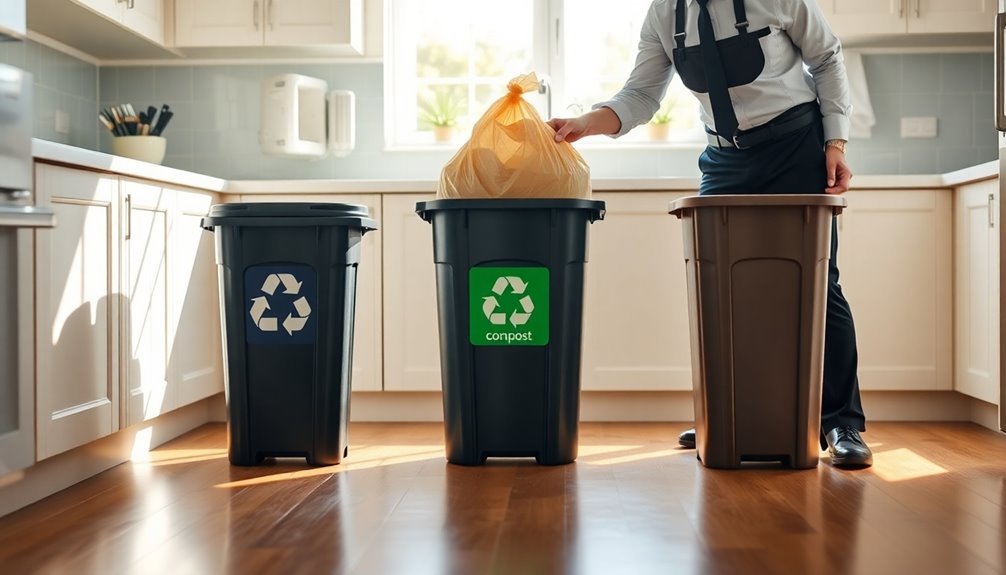
Strategically placing trash bins throughout your space can make a considerable difference in maintaining cleanliness and encouraging proper waste disposal. Start by positioning non-conspicuous rubbish bins at entrances; this encourages immediate disposal of trash brought indoors, effectively reducing clutter.
Think about your cleaning routine and place bins in high-traffic areas like the kitchen, living room, and home office. This promotes proper waste disposal habits and considerably decreases the time you spend cleaning. Additionally, implementing a 10-minute tidy-up routine daily can help reinforce these habits. Regularly emptying trash bins also contributes to maintaining a clean environment and can help reduce the spread of harmful bacteria that thrive in accumulated waste.
Using appropriately sized bins for different rooms enhances their functionality and prevents overflow, ensuring that waste is managed efficiently. In the bathroom, for instance, a smaller bin might suffice for household items, while larger bins in the kitchen can handle food waste.
Additionally, incorporating decorative or hidden trash bins can improve the aesthetic of your space without sacrificing practicality.
Lastly, don't forget to regularly empty and clean your trash bins. This habit helps maintain a fresh environment and prevents unpleasant odors from accumulated waste. Regular maintenance of cleaning routines can also help in sustaining cleanliness throughout your home.
Common Mistakes to Avoid
When you're cleaning, it's easy to think more is better, but overusing products can leave behind unsightly residue. Using natural cleaning solutions can help reduce the chances of residue formation while ensuring a safe environment. Don't forget to read the manufacturer instructions, as they provide essential guidance for effective use. Paying attention to these details can make a big difference in your cleaning results. Additionally, using non-toxic cleaners can help ensure safety while still achieving effective results. Regular cleaning with eco-friendly methods can also contribute to maintaining a clean and shiny bathroom without harsh chemicals.
Overusing Cleaning Products
Overusing cleaning products is a common mistake that can lead to more problems than it solves. When you apply too much cleaner, you might experience residue buildup on surfaces, causing them to attract more dirt and require frequent cleaning.
Many cleaning products are engineered to work effectively in small amounts, so using more than the recommended dosage can actually diminish their effectiveness and waste your money.
Moreover, excessive use can create harmful chemical reactions, especially if you mix different types of cleaning products. This not only poses safety risks but can also lead to unpleasant odors and irritation.
You might also notice longer drying times, increasing the risk of slips and falls on wet surfaces.
Instead of pouring on more cleaner, try using the appropriate amount and let it sit for a few minutes. This allows the product to break down grime effectively without excessive scrubbing.
By following this method, you'll not only achieve better results but also guarantee a safer and more efficient cleaning process.
Ignoring Manufacturer Instructions
Ignoring manufacturer instructions can lead to a cleaning disaster.
When you skip these guidelines, you're not just risking ineffective cleaning; you're opening the door to potential damage and hazards.
Cleaning professionals always emphasize the importance of following these instructions for a reason.
Here are four common pitfalls to avoid:
- Mixing incompatible cleaning products: This can cause dangerous chemical reactions, making your cleaning efforts futile.
- Using the wrong cleaning agents: Not all cleaners are suitable for every surface. Ignoring this can damage your materials.
- Overusing cleaning products: Using more than recommended leads to residue buildup, making future cleaning much harder.
- Neglecting specific application methods: Each product is designed with a unique application process for ideal results.
Importance of a Cleaning Plan
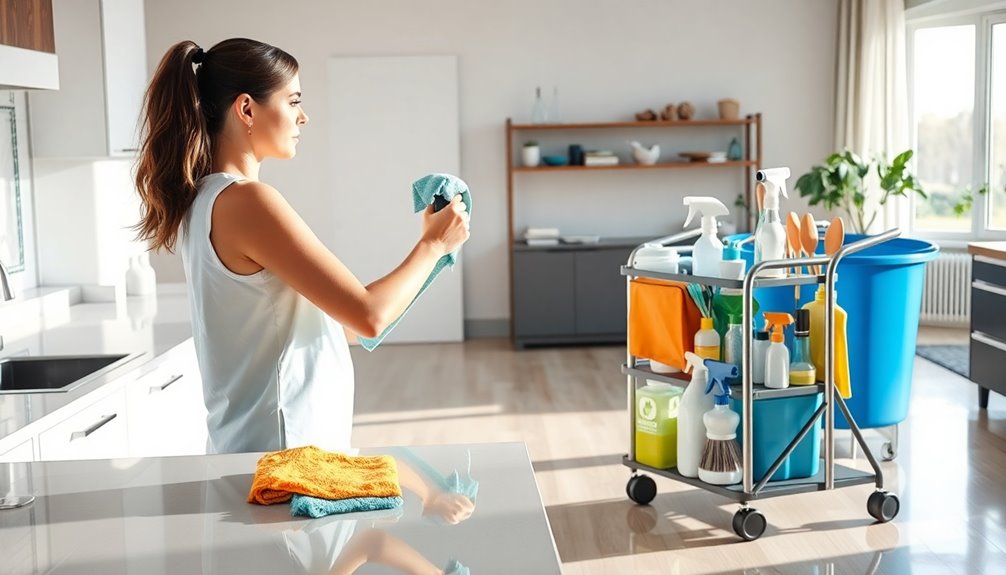
A solid cleaning plan is essential for anyone looking to maintain a tidy and healthy space. By creating a structured cleaning strategy, you streamline the cleaning process, ensuring no areas are overlooked. This approach not only maximizes overall efficiency but also helps you manage your time effectively.
Just like professional cleaners, you can use checklists to track each cleaning task, providing a clear outline of your priorities.
Incorporating regular cleaning schedules—weekly and monthly—ensures thorough maintenance, preventing dirt and grime build-up over time. With a well-defined plan, you can multitask effectively, allowing cleaning products to work while you tackle other chores, leading to efficient cleaning.
Moreover, having a cleaning plan improves consistency in your results, creating a healthier living environment. By committing to a structured approach, you'll notice the difference in your space and your overall cleaning experience.
Time-Saving Techniques
When it comes to cleaning, prioritizing tasks can make a huge difference in saving time.
By focusing on high-impact areas first and using multi-tasking strategies, you can tackle chores more efficiently.
Let's explore how these techniques can transform your cleaning routine.
Efficient Task Prioritization
Maximize your cleaning efficiency by prioritizing tasks strategically.
Efficient task prioritization helps you tackle high-traffic areas first, ensuring your home remains hygienic and manageable.
Use a systematic approach to prevent dust and debris from falling onto already cleaned surfaces.
Here are four key steps to evaluate:
- Create a cleaning checklist: Organizing tasks not only clarifies what needs to be done but also helps you stay focused.
- Focus on high-traffic areas: Start with kitchens and bathrooms. They require the most attention to prevent buildup.
- Utilize timers: Set a timer for each task to instill a sense of urgency, pushing you to complete chores more quickly.
- Incorporate regular maintenance: Daily quick clean-ups minimize the need for extensive deep cleaning, keeping your home consistently tidy.
Multi-Tasking Strategies
Efficient cleaning goes hand in hand with multi-tasking strategies that save you time and effort. By leveraging these cleaning tips, you can maintain a clean home without feeling overwhelmed.
Start by allowing your cleaning products to activate while you tackle other tasks. For instance, let a bathroom cleaner sit while you dust surfaces in another room. This systematic approach guarantees thoroughness without wasting time.
Combine similar cleaning tasks to streamline your process. Dust surfaces before vacuuming to capture any debris that falls. Setting timers for specific tasks can create a sense of urgency, helping you stay focused and efficient.
You'll find that breaking down your cleaning into timed segments can make the workload feel lighter. Incorporate quick clean-up routines into your daily habits. Wipe down surfaces and pick up clutter regularly to prevent mess from piling up.
This not only reduces the time needed for extensive cleaning sessions but also keeps your space inviting. With the right tools for the job and a commitment to multi-tasking, you'll see significant improvements in your cleaning efficiency, giving you more time for what you enjoy.
Eco-Friendly Cleaning Options
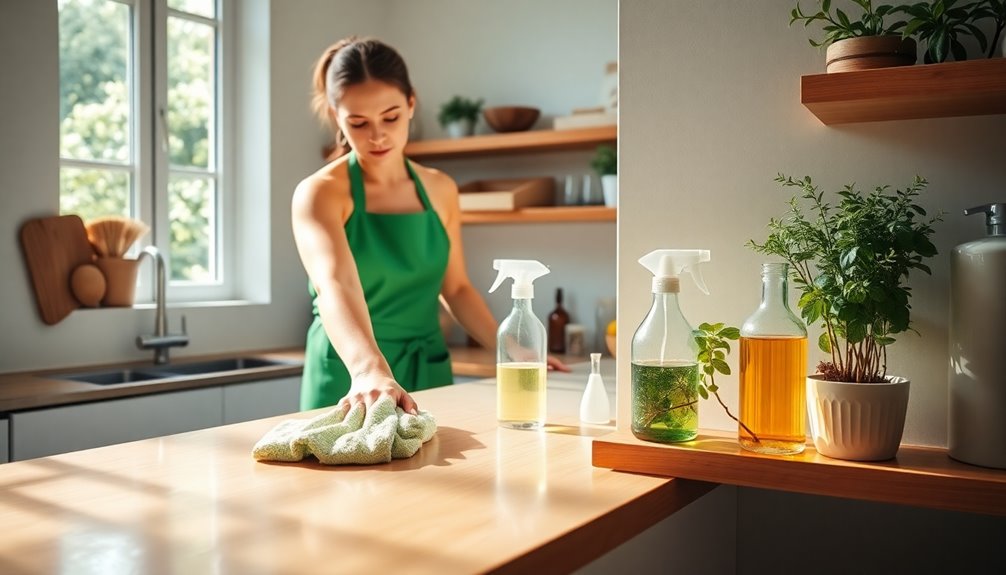
Embracing eco-friendly cleaning options not only benefits your home but also the planet. By choosing natural ingredients and sustainable practices, you create a healthier environment for your family while reducing your ecological footprint.
Here are four effective eco-friendly cleaning options to take into account:
- Vinegar & Baking Soda: These household ingredients tackle stains and odors without harmful chemicals.
- Biodegradable Products: Opt for cleaning solutions that break down naturally, minimizing water pollution and environmental impact.
- Multi-Purpose Cleaners: Invest in all-purpose eco-friendly cleaners that serve multiple functions, reducing waste and ensuring safety for both humans and pets.
- Reusable Cleaning Tools: Use microfiber cloths and washable mop pads to enhance cleaning efficiency while cutting down on single-use waste.
When you switch to these eco-friendly cleaning options, you're not just cleaning your home; you're making a positive impact on the world around you.
Tools for Tough Areas
Cleaning those tough-to-reach areas in your home can be a challenge, even when you're using eco-friendly products. To tackle grime and dirt effectively, you'll want to arm yourself with the right cleaning tools. Extendable tools, like dusters and brushes, are essential for reaching high corners and ceiling fans without needing a ladder.
Microfiber cloths are your go-to for versatility; they trap dust and dirt on both hard and soft surfaces without extra cleaning products. When it comes to upholstery and tight spaces, vacuum brush attachments make a significant difference, ensuring thorough dust and debris removal.
For those really tricky spots, consider using specialized tools like old toothbrushes or butter knives. These can easily scrub out grime in window tracks and around bathroom fixtures, enhancing your overall cleaning efficiency.
Melamine sponges are also great for tackling tough stains and scuffs on walls and baseboards, serving as a budget-friendly alternative to pricier options.
Understanding Product Use
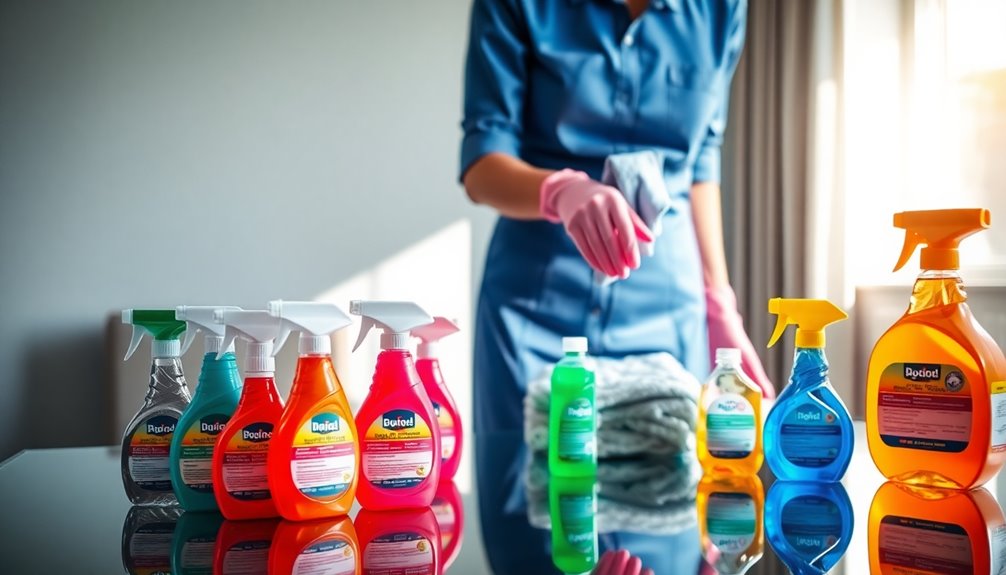
When it comes to effective cleaning, understanding the specific surfaces and materials in your home is vital for selecting the right products. Different surfaces require tailored cleaning methods to avoid damage and guarantee effectiveness. Here are some key points to remember:
- Know Your Surfaces: Identify which cleaning products are suitable for wood, tile, or glass to avoid damaging them.
- Let Products Sit: Allowing cleaning products to sit for at least 15 minutes boosts their efficacy, breaking down grime and disinfecting surfaces effectively.
- Be Aware of Product Interactions: Knowledge of how certain cleaners interact is essential. Mixing products can lead to dangerous chemical reactions, so always use them as intended.
- Choose Eco-Friendly Options: Opt for eco-friendly cleaning products that promote a healthier home environment and reduce reliance on harsh chemicals.
Regularly checking and restocking your cleaning supplies guarantees you have the right tools on hand for different tasks.
Regular Maintenance Practices
To keep your home consistently clean and inviting, establishing regular maintenance practices is crucial. Start by implementing a daily tidying routine. This prevents clutter accumulation, making deep cleaning feel less overwhelming.
Focus on high-traffic areas like bathrooms and kitchens, cleaning them multiple times a week to avoid stubborn buildup and guarantee hygiene.
Adopt a "clean as you go" approach during daily activities. This simple habit minimizes messes and saves you time on extensive cleaning sessions later.
Regular organization and decluttering sessions are also imperative; they greatly decrease the effort required for cleaning your home, allowing for smoother maintenance.
Don't forget about consistent dusting. Create a schedule that includes monthly deep dusting sessions to keep hidden areas free of considerable dust accumulation. This will help reduce allergens and improve your home's air quality.
By prioritizing these practices, you can maintain a fresh and healthy environment with less effort. Regular maintenance isn't just a chore; it's a commitment to your living space that pays off in peace of mind and comfort.
Conclusion
Incorporating these cleaning techniques into your routine can transform your space from chaotic to pristine. By mastering effective start techniques, utilizing essential tools, and understanding product use, you'll not only enhance your efficiency but also achieve impressive results. Embrace specialized tips, explore eco-friendly options, and prioritize regular maintenance to keep your environment fresh and inviting. With these strategies in hand, you're ready to tackle any mess and enjoy a cleaner, healthier home.